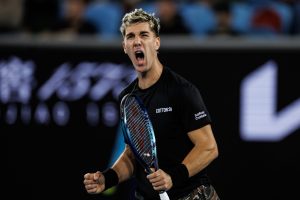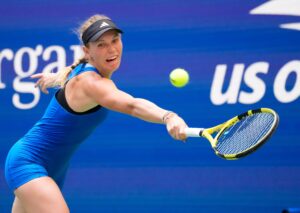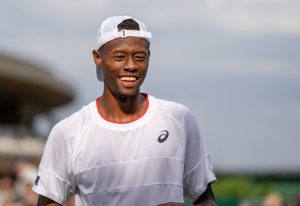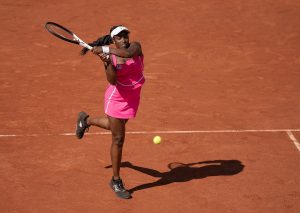Thirteen was certainly the unlucky number for Federer and Nadal this week, as the new world rankings found them both outside the world’s top four for the first time in thirteen years. At that time, Federer had won Wimbledon for the first time and Nadal was just a 16-year-old (albeit a freakishly powerful one) heading for the world’s top 50. Since then, of course, the pair have been so dominant in men’s tennis that they have become inextricably linked with each other and are usually referred to simply as “Roger and Rafa” (and perhaps in time that will be further shortened to just “R & R”). For so long they were part of “the big four”, along with Novak Djokovic and Andy Murray. Indeed, between 2005 and 2010 (before Djokovic began his rise to the #1 ranking), they were so all-conquering that they were effectively a top two, with everyone else miles (and hundreds of ranking points) behind. Now, however, with both of them slipping out of the world’s top four at the same time, it is impossible not to wonder whether the Federer-Nadal rivalry, which has constituted arguably the greatest rivalry in tennis history, is finally coming to an end.
In many ways, of course, it was not a surprise to see Nadal at #5 and Federer at #7 in the new world rankings, because both men have undeniably been in decline for several years now. In Federer’s case time and injury finally caught up with him in 2016. First, he missed the French Open with a back problem, which ended his scarcely believable run of competing in 65 consecutive Grand Slams since the Australian Open in 2000. Then at Wimbledon, during his semi-final loss to Milos Raonic, the Centre Court crowd was astonished to see him receiving on-court treatment for the first time that anyone could remember. Finally, after Wimbledon he succumbed to serious injury for the first time in his career, as his persistently troublesome knee ruled him out of the Rio Olympics and the rest of the season.
At 30, Nadal is five years younger than Federer, so it was not simply age catching up with him this week as he suffered another surprise defeat to Victor Troicki at the Shanghai Masters. In Nadal’s case, it is not so much the years taking their toll as the mileage. He broke through at a much earlier age than Federer. The Spaniard was just 18 when he won his first Slam, the 2005 French Open, whereas Federer was comparatively ancient at 22 when he first won Wimbledon in 2003. In addition, his ultra-physical playing style has always exacted a much greater toll on his body than Federer’s more fluid movement has on his. Roger has always seemed to glide around the court, while Rafa rumbled and roared, and as a result Rafa has missed many more Grand Slam events in his career than Roger.
Also, after winning so many Grand Slams for so long (at 17 Major wins, Federer remains three ahead of both Nadal and Pete Sampras in the all-time list of men’s Major winners), both men have now gone an awfully long time without winning even one. For Federer, it is more than four years since he won his seventh Wimbledon title, but Rafa has also faltered in the Majors in recent years, last winning one at the French Open in 2014. It is a testament to Novak Djokovic’s sustained success over the last five years that he has so completely overshadowed Federer and Nadal, to an extent that was absolutely unthinkable when both men were in their pomp.
Does Rankings Fall Signal The End Of The Federer-Nadal Rivalry?
Of course, as they say at Mormon weddings, it’s all relative. Most tennis players would be absolutely thrilled to still be in the world’s top 10 after the age of 30, and there is still the possibility that either, or even both, Federer and Nadal might yet win another Slam. But what seems increasingly certain is that neither player will ever again enjoy anything like their previous dominance, and the chances of their playing each other once more in a Major final are remote, to say the least.
If that is the case and we have seen the last of Roger and Rafa competing against each other at the top of the men’s game, where will the two of them ultimately be ranked in tennis history? And more specifically, where does their rivalry rank, not only in tennis itself but in the whole of sport?
Regarding their individual rankings in the game’s history, it is easy to make a case for their being, quite simply, the first and second best men ever to play tennis. It is not just a question of Major success, although they remain respectively the most successful and the joint second most successful players in terms of Grand Slam wins. It is also the fact that between them they truly catapulted tennis into the 21st century, with contrasting styles that made for the perfect on-court rivalry. Federer the greatest and most graceful attacking player ever to wield a racket (at his best, he wielded a tennis racket with as much élan as William Shakespeare wielded a quill); and Nadal unquestionably the greatest clay-court player ever (his total of nine wins in Paris is a record for any of the four Grand Slam events) and arguably the greatest defensive player ever. Mitch Hedberg, the great American comic, told the ultimate tennis joke when he said, “The depressing thing about tennis is that no matter how good I get, I’ll never be as good as a wall.” Well, if any player ever came close to being as good as a wall – just returning the ball one more time, seemingly infinitely – it was Nadal.
The greatest sporting rivalry of all time?
As for how their rivalry compares with other great tennis rivalries, the obvious comparison is with that of Borg and McEnroe. For many years, Borg and McEnroe was considered to be the greatest rivalry in tennis (certainly in men’s tennis). With the imminent release of the “Borg/McEnroe” movie, which focuses on their amazing 1980 Wimbledon final, many may yet make the case for them again. Certainly, theirs was a more obvious rivalry than that of Federer and Nadal, simply because they were so different – the supposedly ice-cold Swede versus the hot-headed American, etc. – in a way that the equally charming and gracious Federer and Nadal could never emulate. However, just as the epic Borg-McEnroe 1980 Wimbledon final was finally eclipsed by the even-more-epic 2008 final between Federer and Nadal, so the overall Federer-Nadal rivalry has come to overshadow that of Borg and McEnroe. The statistics certainly back up that assessment. Not only have Federer and Nadal won more Major titles between them than Borg and McEnroe (31 to 18) and played more Grand Slam finals against each other (eight to four), but both Federer and Nadal have achieved the Career Grand Slam (winning all four major titles at some point), whereas neither Borg nor McEnroe achieved that stellar feat.
Ultimately, therefore, it is with the great rivalries of other sports that Federer-Nadal must be compared. Indeed, it is with the greatest sporting rivalry of all that theirs deserves comparison. That, of course, is Ali-Frazier in boxing. Just as Ali and Frazier fought it out in three extraordinary fights over four years in the early 1970s, culminating in the “Thriller in Manila” in 1975, so Federer and Nadal fought each other continually for nearly a decade to achieve pre-eminence in men’s tennis. Because of that, they are effectively yoked together for the ages, just as Ali and Frazier are. The difference, of course, is that Ali and Frazier literally fought each other to a standstill, with both men suffering such horrendous injuries in their Manila decider that neither of them ever fully recovered. In comparison with that, Federer and Nadal’s gentle (if possibly irreversible) slide out of the tennis world’s top four is not nearly so disastrous.
Main Photo:






